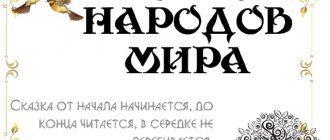World Games
Game TALKI (FIT), Russia
At the command of one of the players - tag (tag) - all the others scatter. The task of the tag-driver is to catch up with the one running away and make him look dirty. The salty one becomes the driver. Each new driver raises his hand and shouts: “I’m a tag!” It is not allowed to immediately stain the previous tag. To complicate the game, you can set the following, say, additional rules: you cannot salt someone who manages to fall to the ground, leaning on the palms and toes of outstretched legs; or freeze on one leg, holding the other leg laid back with both hands. And we can agree that the one who touches wooden, iron, stone objects with his hand will be safe from the tag. You can also escape in the “house” - a specially outlined circle, etc. The game becomes even more interesting and a little more difficult if you spot not with your hand, but with a small ball.
Balteni game, Latvia
The number of participants in this game is 5 or more. To play you will need a well-hewn wooden stick. First you need to choose a leader. Then all players should lie face down on the grass, and the leader should throw the stick into the bushes so that the players do not find it right away. On command, everyone lying down jumps up and runs to look for a stick. The one who does it the fastest wins. The winner becomes the host.
Game “WOLF IN RVU”, Russia
This ancient game can be a great way to entertain you during recess in the school yard. A corridor up to one meter wide is drawn on the site. The ditch can also be drawn in a zigzag pattern - narrower in some places, wider in others. In the ditch there are drivers - “wolves” - two, three or more: it’s just as you want. All the other players - the “hares” - try to jump over the ditch and not get stained. If the “hare” is stained, he is eliminated from the game. “Wolves” can stain “hares” only while in the ditch. “Hares” do not run across the ditch, but jump over it. That's all the rules. Come up with options yourself...
Game "Belyak", Belarus
This game can be played by 5 or more people. You can play "Belyak" only in winter. To do this, participants need to roll a large ball (diameter - 1 m) out of snow and stand around it, holding hands. Afterwards, each participant must try to pull someone by the hands into the middle of the circle so that he touches the ball with his body. If there really was a touch, the participant is eliminated from the game. Those remaining join hands again and continue the game. The winner is the one who makes the last opponent touch the ball.
Calabash game! (home), Peru
The players draw circle houses for themselves, and the driver remains “homeless.” Everyone shouts in unison “Kalabasa!” (Go home!) and scatter in their own circles. The “homeless man” turns to one of the players: “Are you selling eggs?” He replies: “I don’t, but maybe he’s selling,” and points to a friend, to whom the “homeless man” goes. In the meantime, the players must change places. If the driver manages to occupy someone else’s house, then he becomes its owner, and the one who remains outside the circle leads.
Running with a Scarf Game, Canada
This game can be played by 10 people or more. First, you need to choose a leader among the players. After this, the players stand in a circle, the leader with a scarf runs around it 2 times, touches someone’s back, puts the scarf behind his back and continues to run. The essence of the game is that the player who was touched by the leader must pick up the handkerchief, overtake the leader and return to his place. In this case he wins. If the player does not have time to overtake the leader, he loses and takes his place.
Game “Give me a handkerchief”, Azerbaijan
Children of primary and secondary school age play, from 6 to 40 people. The game requires two small scarves. The players are divided into two teams of equal numbers and lined up one against the other along opposite sides of the court at a distance of 10 - 15 m from each other. Hands are held behind the back. The selected team captains, having received a handkerchief, walk around the back of their ranks and discreetly put the handkerchiefs in the hands of one of the participants standing in the line, so that the others do not notice to whom the handkerchief was given. Then the leader of the game (leader) says: “Give me a handkerchief!” Those who have the scarves quickly run out and hand them over to the leader, who stands in the middle near the side line. Which of the running out participants is the first to hand over the handkerchief receives 1 point for their team. The team with more points wins. The same player cannot run out twice (that is, the same player should not receive a handkerchief more than once. Without a command from the leader, it is not allowed to run out of the line.
Game "White Stick", Tajikistan
More than 10 people can play White Stick. Participants must choose a leader according to the counting count, divide into 2 equal teams and choose a place for the white stick. Then the leader must quietly hide the wand, and the players must look for it. The one who finds the stick carries it to the chosen place, and at this time the players of the other team try to stop him. The wand can be given to your team members.
Punipuni game, New Zealand
This is a Maori game played by two people. Players stand facing each other at a distance of about 2m. One extends his hand in the direction of the other, and the other, with his eyes closed, tries to find his friend’s hand, reach for it and cross his fingers. At the same time, both should not move.
Game "Bilyasha" *, Republic of Mari El
In books of the last century, this game is mentioned as one of the original Cheremis (Mari) or Turkic games. It is still played by teenagers and young people. The number of participants is from 8 to 30 people. Two parallel lines are drawn at a distance of 4 m from one another. Players are divided into two teams and stand in ranks facing each other behind parallel lines. A player who volunteered from one of the teams, shouting “Bilyashal”, runs to the other team, each member of which extends his right hand forward. The person running up, grabbing someone by the hand, tries to pull the opponent across the court and behind his line. If he pulls him over, he makes him his “prisoner”, placing him behind him. If he doesn’t win, but he himself ends up behind the line of the other team, then he becomes (like a “prisoner”) behind the back of his winner. The player is then sent out by the other team. He also grabs the hand of his opponent, whom he hopes to pull over his line. They especially try to pull over the one who has a “prisoner” in order to free him in case of victory. So the teams take turns sending out their players. The game ends with one team gradually winning over all its opponents. During the game, teams cheer on their players by chanting their names. Rules. 1). For tug-of-war, you can choose any player of the opposing team! no one should withdraw their outstretched hand. 2). You can pull only with one hand, without the help of the other. 3). The freed “prisoner” returns to his place on the team.
Fish in a Net game, New Guinea
Players are divided into two groups, and one becomes a ring around the other. Inside there are “fish” - players who must slip out of the “net”. According to the rules of the game, this can only be done by crawling between the legs of your comrades. When someone succeeds, the players change roles. This game can also be played in water.
Game “Painter and Paints”, Tatarstan
The game involves mainly children of preschool and primary school age, from 5 to 40 people. At a distance of 20-30m, draw two parallel lines. Gymnastic benches are installed on one of them. On the side between the lines a circle with a diameter of 3-4 m is drawn - “the painter’s house”. They choose a driver and a “painter”, the rest of the players become “painters”. “Paints” sit on benches or on the grass in one row. Having sent the “painter” to his house, the driver distributes paints among the players: red, green, yellow, etc. At a signal from the manager, a “painter” approaches the driver (he is standing next to the “paints”) and asks: “Grandma, grandma, I came for paint.” May I take it? - I, my friend, have a lot of colors. Which one should I give you? “Painter” names some kind of paint, for example red. A participant in the game, called “red paint,” quickly gets up and runs to the second line. The “painter” tries to catch up with him and touch him with his hand. If he succeeds, then he takes the “paint” to his “home”. If the “painter” does not catch the “paint,” then it returns to its “house” (on the bench) and “changes” its color. After this, the game repeats. Rules.1). You can only catch the paint up to the opposite line of the court. 2). The “painter” is prohibited from catching a player until he gets up from the gymnastics bench or from the ground. 3). Before reaching the second line, the “paint” has no right to go back and sit on the bench.
Game "Tags", Poland
The number of participants in this game is unlimited (from 2 people). Before the game, you need to prepare 10 tags - 8-centimeter boards cut from wood. The tags form pairs: emperor and empress, king and queen, prince and princess, peasant and peasant woman (2 pairs). During the game, the first participant must take all the tags in his hands, throw them and try to catch them in the palm of his hand with straightened fingers. Only matched pairs are considered caught. 12 points are given for the imperial one, 7 points for the royal one, 4 points for the prince and princess, and 1 point for the peasants. The winner is the one who scores the maximum number of points in a certain number of throws.
Sick Cat Game, Brazil
This game can be played by up to 5 people. One of the players is selected to be the “healthy cat” and whose task is to catch and stain the rest of the participants. The spotted participants must help the “healthy cat” by holding with one hand the place that she touched. The “sick cats” can only spot the remaining participants with their free hand. The remaining untainted participant becomes a “healthy cat” in the next round of the game.
"Bulava", Azerbaijan
10 people or more can play. To begin, participants must choose a leader, divide into two teams, stand opposite each other in rows and pay off by numbers. Then a penalty line must be drawn in front of each team, and a circle between them. A mace should be placed in the center of the circle. Next, the presenter must name the numbers of two participants from both teams, and they, in turn, run to the center of the playing field and try to grab the mace. The participant who takes the mace first must quickly return to his team, and the loser tries to touch him and touch him. In the event that the losing participant catches up and stains the winning one, the losing team gets a point. If the participant who took the mace manages to bring it to his team unsullied, the point is awarded to them. You can touch the winning player if he has not yet reached his penalty line.
FIRE TEAM Germany
10 or more people play. Chairs according to the number of players are placed in a circle, with their backs facing inward. The players (firemen) walk around these chairs to the sounds of music (tambourine, drum). As soon as the music stops, players must place an item of clothing on the chair they are standing near. Game continues. When each participant removes 3 objects (they end up on different chairs), the alarm sounds: “Fire!” Players must quickly find their items and put them on. Whoever gets dressed the fastest becomes the winner.
TRAINS Argentina
7 or more people play. Inventory: whistle. Each player builds a depot for himself: he draws a small circle. In the middle of the platform there is a driver - a steam locomotive. He doesn't have his own depot. The driver walks from one carriage to another. Whoever he approaches follows him. This is how all the cars are assembled. The locomotive suddenly whistles, and everyone runs to the depot, including the locomotive. The player left without a seat becomes the driver - the locomotive.
FIND THE SCARF! Austria
Four or more people play. Inventory: scarf. Progress of the game. The players choose a driver who hides the handkerchief, and the rest close their eyes at this time. The scarf is hidden in a small area, which is marked in advance. Having hidden the scarf, the player says: “The scarf is resting.” Everyone begins to search, the search is directed by the one who hid it. If he says “warmth”, the person walking knows that he is close to the place where the scarf is located, “hot” - in the immediate vicinity of it, “fire” - then he must take the scarf. When the seeker moves away from the place where the scarf is hidden, the driver warns him with the words “cool”, “cold”. The one who finds the handkerchief does not talk about it, but quietly creeps up to the player who is closest to him and hits him with the handkerchief. In the next round he will hide the scarf.
Fire brigade (Germany)
10 or more people play. Chairs according to the number of players are placed in a circle, with their backs facing inward. The players (firefighters) walk around these chairs to the sound of music (tambourine, drum). As soon as the music stops, players must place an item of clothing on the chair they are standing near. Game continues. When each participant removes 3 items (they end up on different chairs), the alarm sounds: “Fire!” Players must quickly find their items and put them on. Whoever gets dressed the fastest is the winner.
Trains (Argentina)
7 or more people play. Inventory: whistle. Each player builds a depot for himself: he draws a small circle. In the middle of the platform there is a driver - a “locomotive”. He doesn't have his own depot. The driver walks from one “car” to another. Whoever he approaches follows him. This is how all the “cars” are assembled. The “steam locomotive” suddenly whistles, and everyone runs to the depot, the “steam locomotive” too. The player left without a seat becomes the driver - the “locomotive”.
Sick cat (Brazil)
More than 5 people play. One player is a healthy cat who tries to catch everyone else. Each player who is tainted must place their hand on the exact spot where they were tainted. He also becomes a cat, but a sick one, and helps the healthy cat when catching. A sick cat can only stain with its healthy hand. The player who is not stained wins. He becomes a healthy cat for the next round.
Alone in a circle (Hungary)
5 people or more play. Equipment: ball. Players stand in a circle and throw a large, light ball to each other until someone makes a mistake and drops it. This player goes into the circle and stands in the middle. The players continue to throw the ball, but try not to be grabbed by the player standing in the center, but the ball hits him. If, nevertheless, the central player manages to catch the ball, then he can throw it at anyone. Whoever it hits takes his place. The game becomes more interesting if it goes at a good pace and with a quick pass you can make the person standing in the center spin and jump a lot.
Good morning, hunter! (Switzerland)
10–15 people play. The players stand in a circle and choose a hunter who walks behind the players. Suddenly he touches the player's shoulder. The one touched turns and says: “Good morning, hunter!” - and then goes in a circle, but in the direction opposite to where the hunter is going. Having walked half a circle, they meet, the player again says: “Good morning, hunter!” And both run to take an empty place in the circle. The one who did not manage to do this becomes a hunter.
Pull out your scarf (Azerbaijan)
10 or more people play. Inventory: scarves. Two teams line up opposite each other at some distance. A line is drawn between them. Each person has a handkerchief or scarf tucked into the back of their belt. By lot, one of the teams becomes the driver. At the judge’s command, the children move forward (the drivers stand still), cross the line, and then the judge shouts: “Fire!” The players run back, and the opponents (drivers) try to catch up with them in order to pull out the scarf from their belts. Then the teams change roles.
The team that captures the most scarves wins.
Lame duck (Ukraine)
10 or more people play. Mark the boundaries of the site. A “lame duck” is selected, the rest of the players are placed randomly on the court, standing on one leg, and holding the other leg bent at the knee from behind with their hand. After the words “The sun is shining, the game begins,” the “duck” jumps on one leg, holding the other leg with his hand, trying to make fun of one of the players. The greasy ones help her to grease others. The last remaining player becomes a lame duck.
Rule. A player who stands on both feet or jumps out of bounds is considered stung.
Statue (Armenia)
5–20 people play.
Players are divided into catchers and runners. One catcher is assigned for every 5 people, and four catchers for every 20 people. At the direction of the leader, the catchers go outside the field, and the runners freely position themselves on the site. At the signal, the catchers chase the other players, trying to catch one of them. The person who has been exposed must immediately stop (freeze in place) in the position in which he was exposed. Anyone who is frozen can be “released” by any player by touching him. The game ends when all players are killed. After this, new catchers are chosen and the game continues. Rule 1. You can hit a player by touching your palm to any part of the body except the head. Rule 2. A runner who, by inertia, runs out of bounds is considered out of the game.








